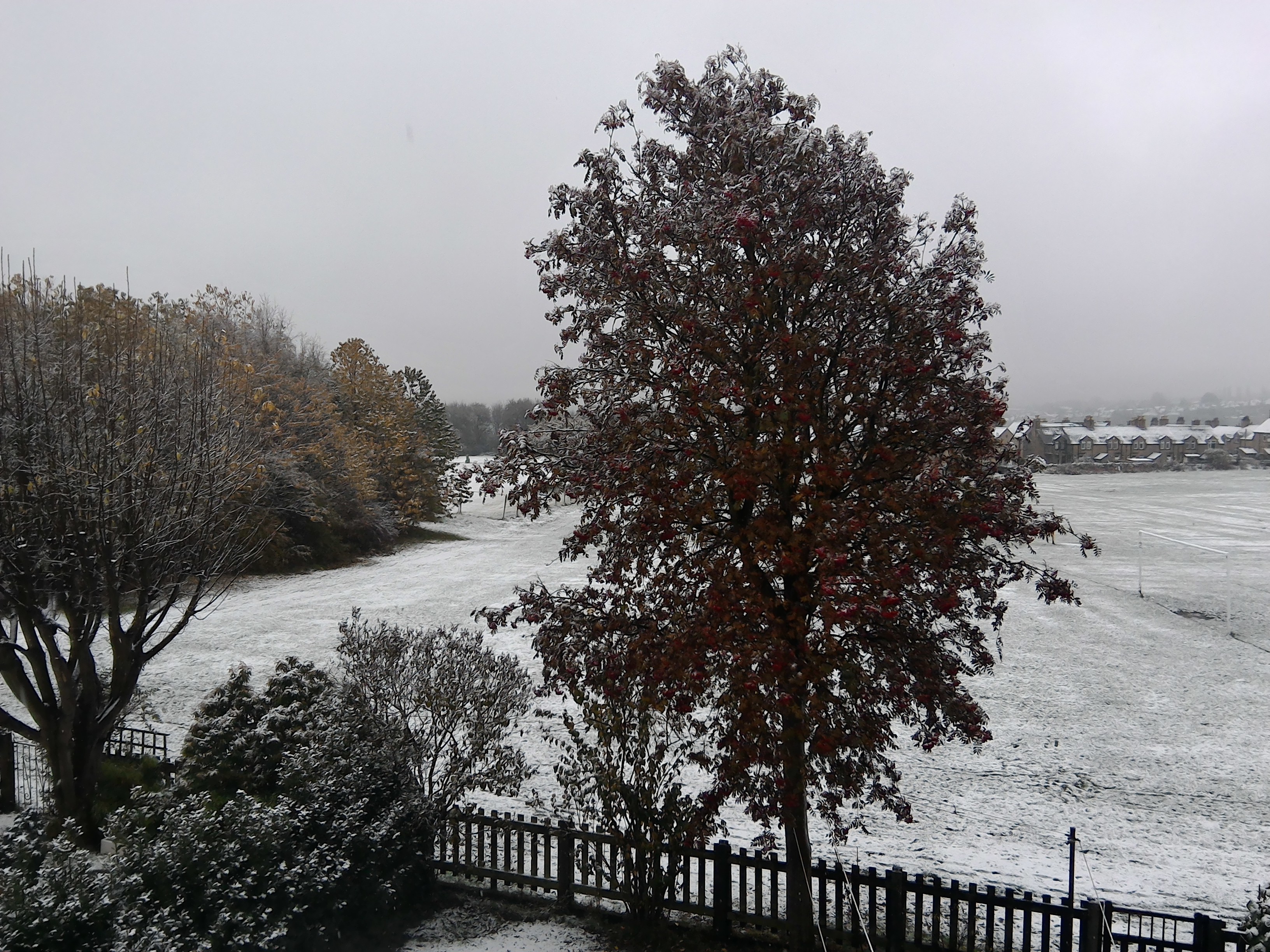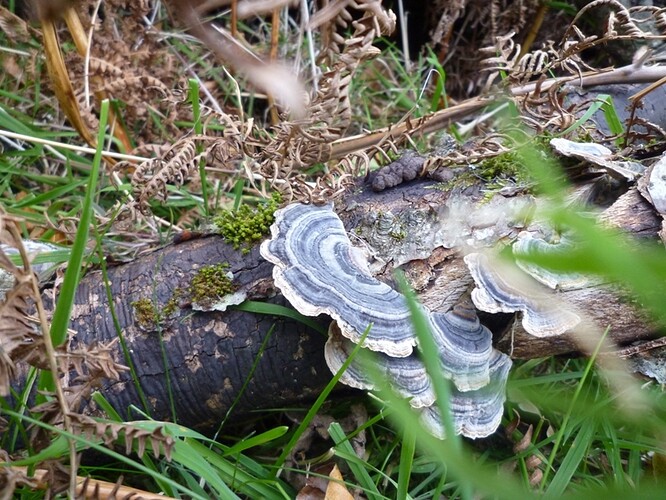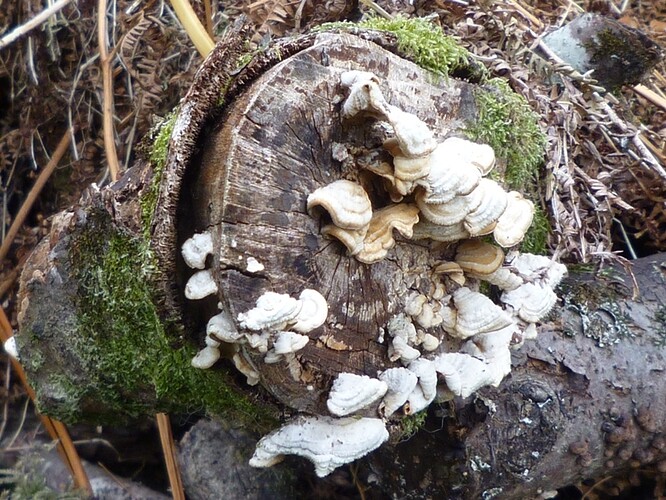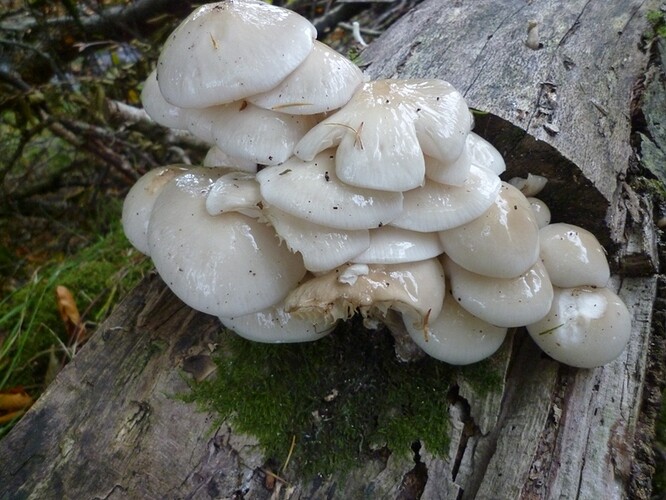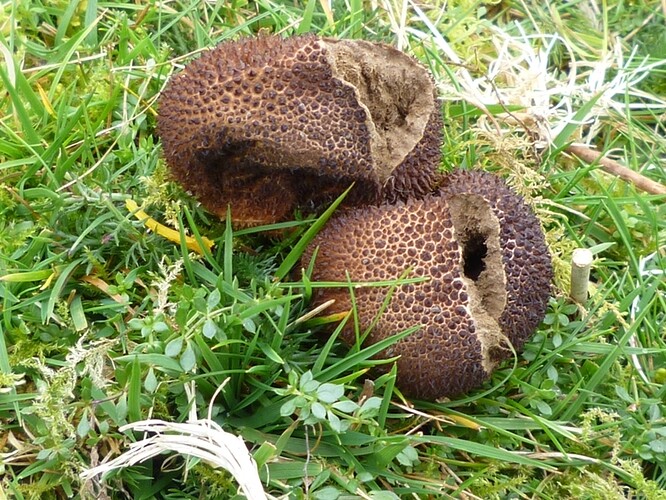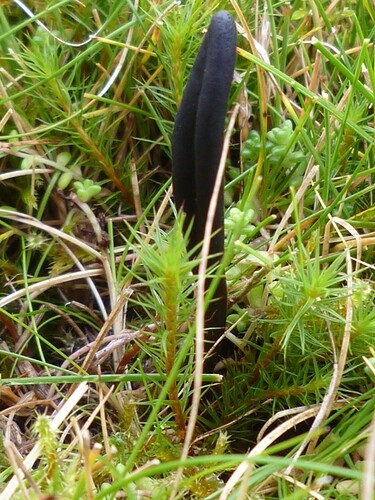Diolch, JP! In fact, now you’ve jogged my memory, that’s also what Twm Elias suggested! Hwyl fawr, John
We were told the story of the Salem witches at Y Plas & learned of ‘ergotism’ & the ‘ergot’ fungus. I’d never heard of it before. Wikipedia has a page that I’m not clever enough to link here.
That’s interesting - I hadn’t heard of the link to the Salem witches before. I remember, though, there was a suggestion a good few years ago that the 19th C mystery of the Mary Celeste, found sailing in the Atlantic without a crew, resulted from them eating bread made with ergot contaminated flour and suffering halucinations which were so terrifying that they abandoned ship
A hairy mushroom I’ve been trying to identify without much lwc.
Found on a woodland floor. Best guess is a type of ‘web cap’.
A dung mushroom, not in focus but complete with maggot. I thought it looked as if it had a crocheted edge.
An impressive (to me, probably not the trees!) bracket fungus. Ffwng ysgwydd.
My best guess is Alder Bracket but I failed to note the tree type! It was present on a number of trees in this little copse - coedlan.
Of rye, yes? Very common once and it was the poor who couldn’t afford wheat flour and widows tended to be poor! I know much more weird and wonderful history than botany!! (Never studied the latter and have always been fascinated by the former!)
My softer side, John bach, never is seen by an arachnid and any animal which is tasty - I was raised when rationing encouraged the keeping of rabbits for meat and chickens for eggs and meat! But eating amphibians never appealed! Meal worms, I feed to birds, never myself and I have never fancied a witchetty grub, which I know are food in Australia!
p.s. Will cuddle baby lamb on lap, or rabbit ditto, doesn’t stop me seeing them as a potential meal, although mixi put me off wild rabbits!
mae’r mynd yn anodd hyn - this is getting difficult (not sure if the welsh is correct).
It does appear to have the features of Inocybe lanuginosa.
cloch ddanheddog - mottle gill (the edge decoration is a give away, (as are the mottled gills)).
Occasionally on other species of tree (according to my book!).
Helping deliver the lamb of a struggling sheep can be such a touching pleasure, yes they are potential food, but it does not stop us having a soft center,
(go on admit it, henddraig by name, fluffy bunny by nature) (chwerthin amdani)!!
Mae’r lleuad heno.
Cheers J.P.
@pippapritchard. i have given this one a bit more thought (check if the trees are any prunus species (ceirios - cherry and ddraenen ddu - black thorn are popular) this may be
phellinus pomaceus, i will try to photograph an example on ornamental cherry in town this week for comparison.
Cheers J.P.
I’ll be back there early next week so I’ll have a better look. Looks possible from Googling it. Diolch i ti JP.
Hope its not covered with snow! It seems to be staying east of us, but travelling south!
Oedd hi wedi bwrw eira wythnos diwetha. (It had snowed here last week) but it was only on the tops and once the sun came through it melted away in a couple of hours.
Well …
Danni’n medru gweled ei fod yn mis Tachwedd rwan. Mae’r gaeaf wedi cyrraedd.
I hope this means that we can see that it is November now and Winter has arrived. Please correct the Welsh; all suggestions for improvement are welcome.
Heddiw - today.
Phaeolus schweinitzii - Dyer’s mazegill. (oedd yn dechrau tyfu ar hen coed pinwydden yr Alban - has started growing on old Scot’s pine.)
Coesyn rhychog gwyn braidd yn mawr - white helvella quite large.
Coes las y maes - Field blewit.
Ymenyn y eithin - yellow brain fungus.
Cheers J.P.
The more you show us, the more I wonder how,I have lived this long and missed seeing so many fungi! I only really looked if I saw something I knew could be eaten!
I continually live with the idea that i may have gazed across the ocean of life, but doubt i have seen or experienced but one cup full (not complaining, i feel lucky in many ways, forums are a way to share and i thank all contributors).
I have just returned from a talk about he origin of bird names which was extremely interesting and one of those occasions when i feel time has produced an answer.
Way back somewhere in this thread was a discussion about pioden - magpie and pioden y mor - oystercatcher and how they are not related (closely) birds, i also mentioned at the time that a Pied horse was a black and white one (or it was when i was young).
Well it seems the English pied is derived from a Latin word ‘pica’ (meaning) daubed with tar, now i can see that the pioden and pioden y mor are black and white so the name has nothing to do with family tree but colour (in this case they both look daubed with tar), the pie at the end of magpie carrying the same description.
Also cameras at the ready folks for the super moon on Monday (considering the chance of a clear night i will be looking Sunday evening as well). the effect should be best as the moon appears on the horizon.
Cheers J.P.
Thanks, JP - this has just awakened a long dormant memory about reading somewhere that the name magpie originated in the habit of country folk giving nicknames to birds, so that the Pie became Maggie Pie (I’ve a feeling that in French the magpie is ‘pie’) and the Redbreast became Robin Redbreast. Now I’ve just realised that jac-y-do might mean Jack of the roof, so maybe the English name jackdaw comes from the Cymraeg and not the other way around?
Hwyl, John
da iawn JW. (a like is not enough).
Firstly i must say i am in no way a language boffin, but the talk was far more interesting than i could imagine.
A diagram of language flow included as you mention a lot of Latin/Greek coming through French.
(Welsh was on one side of the diagram).
There was a lot of information to get through in a slide show, so no doubt his book would give far more comprehensive information, it is called (‘Lapwings, Loons and Lousy Jacks’ by Ray Reedman).
There was even a section of how sometimes the American bird name can be more correct because of where the early settlers came from.
I did get to speak with the man after the talk, about the Welsh names (which he does not cover in isolation, more part of local names, the same being true for Cornish), unfortunately i had not taken my Iolo Willams book with me so had to work from memory, this worked fairly well and ended with him asking which part of Wales i was from !
So there we are, where will life + SSI take us next, no idea but it’s fun.
Cheers J.P.
Diolch, JP - this is such a fascinating topic - I’m sorely tempted now to buy a copy of’ Lapwings, Loons & Lousy Jacks’!
Hwyl, John
PS I found this link should anyone else be similarly tempted: http://www.pelagicpublishing.com/lapwings-loons-and-lousy-jacks-the-how-and-why-of-bird-names.html
Some more ffwng from my wythnos Plas Tan y Bwlch, this time on logs (ffwng boncyffion?)
Rather handsome these …
Well, the log seems clear in this photo but the ffwng not so clear, unfortunately!
Impressively shiny - but I should have touched them to see if they were glistening because they wet or because they were waxy - hopefully, though, they can be easily identified just from the photo - @ramblingjohn @pippapritchard ?
We had a discussion about this a while back because I asked about the connection with birds nesting on chimneys and Sion Corn! That may have been in another thread! Certainly a piebald horse or pony is black and white, while a skewbald is any other colour and white! I have not researched where ‘skew’ comes from, or for that matter ‘bald’ in those examples - I presumed an archaic word for colour or coat or look!!!
And finally from the PTyB week, a couple of ffwng appearing in more mossy/grassy (mwsoglyd a gwelltog) environments
Puffball - I was told it’s name in Cymraeg means the wolf’s (blaidd) puffball - still producing plenty of spores
Something very similar seen in Wytham Wood, but this was found several hundred feet up in an open landscape (admittedly with a little shelter from a stone wall) - a relative or the same species, I wonder?
